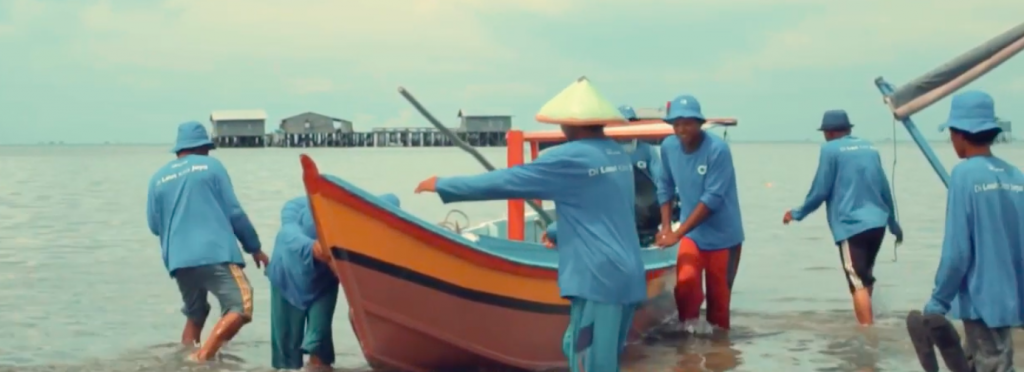There’s growing enthusiasm among young Indonesian startup founders to improve processes in the agriculture and fisheries industries using fresh ideas, but unfortunately few companies are able to find sustainable business models.
Agriculture and fisheries are important markets for Indonesia, while the people working these jobs are among the poorest of the country. Many well-meaning measures to improve living standards still miss their mark, according to Dondi Hananto, partner of Patamar Capital, a venture capital firm focusing on businesses with social impact.
“These sectors aren’t easily transformed digitally. Agriculture and fisheries require highly physical operations and have high servicing costs,” Hananto told KrASIA.
Agriculture is vital to the Indonesian economy as it absorbs labor and drives other sectors within the national economy. According to data compiled by the Central Bureau of Statistics in 2018, there are more than 33 million farmers across Indonesia, not including people whose jobs are indirectly related to agriculture. Most are in the low-income bracket or even teetering on the poverty line.
Indonesian agriculture has unique challenges compared to developed countries. Farmers, especially those who live in rural areas, don’t have access to knowledge and industrial methods for effective and efficient farming, so it’s difficult for them to increase their output.
“In the USA, one farmer may have one hundred hectares of land whilst in Indonesia, the majority of farmers operate less than a one-half hectare. We can’t expect a revenue stream from the farmers, so it is not easy to make a profit in this business,” Hananto said.
In addition, agriculture has a long chain of middlemen between farmers and consumers, which tends to drive prices up for consumers and reduce profits for farmers.
These well-known problems encouraged the emergence of “agritech” startups. Against the odds, some have found modest success.
B2B at the core
One is Tani Group, a tech startup engaged in two main enterprises, TaniHub and TaniFund.
“Our mission is to simplify the farmers’ supply chain and provide access to markets and finance,” said co-founder and president Pamitra Wineka. The TaniHub e-commerce platform connects farmers and buyers, while the crowdfunding platform TaniFund provides loans for members of TaniHub which help to improve production.
TaniGroup is one of a handful of agritech startups that continue to grow. It’s partly possible because it has a B2B business at its core, where it sells large quantities of produce to major corporates, but with “fairer trading terms,” according to Wineka.
But TaniHub also has B2C clients through a simple mobile app, on which it connects smallholder farmers with over 400 SMEs and 10,000 customers. TaniHub claims that farmers can increase their production by 30% after joining the platform. It also targets F&B and retail establishments to distribute fresh supplies. The company manages a warehouse where they process the unsold fresh produce into frozen food to minimize waste and increase profit.

Although TaniHub takes a commission from every transaction on its platform, its focus, for now, is to strengthen the agritech ecosystem. In May, the company raised USD 10 million in a Series A financing round to accelerate new product development and its expansion across Indonesia.
However, its development was not without challenges, Wineka admitted that it was not easy to penetrate this sector because they had to deal with a network that’s used to doing things in a certain way, and whose people were not familiar with new technology. In order to address this problem, TaniGroup collaborates with the leaders of farmer groups and educates them first, letting them pass on knowledge to the group’s members. The leaders are typically relatively young people who are trusted by older farmers, so the introductory and socialization process takes place more easily.
Up to 1,000% price mark-up in the chain
A similar path for growth also worked for Aruna, a fisheries e-commerce platform. The fisheries industry in Indonesia has huge potential; its economic value could reach USD 1.3 trillion per year with a production potential of around 60 million tons per year, according to official government estimates quoted by local media.
However, like farmers, fishermen are also often associated with poverty and underdevelopment, as they have limited facilities, a lack of skills, and are in tight competition with each other. There are many inefficiencies in the system and distrust due to a lack of transparency.
“We focus on simplifying the long supply chain in small-scale fisheries trading, providing information and market prices, as well as improving fishermen’s commodities,” Aruna’s CEO Farid Naufal Aslam told KrASIA.
According to research conducted by Aruna, a fisherman earns only IDR 1.2 million per month (just under USD 85). This low income is partly due to the many middlemen involved in the supply chain. “Fishermen sell their catches to village-level middlemen, who’ll resell them to the district-level middlemen until they are sold to wholesale markets,” Aslam said. In his experience, price mark-up from fishermen to buyers can “range from 70 to 1,000%.”

Aruna built a platform that directly connects groups of small-scale fishermen with industrial-scale buyers. But you can’t take out middlemen altogether. In order to avoid social friction and to speed up the knowledge transfer, Aruna cooperates with village-level middlemen to be group managers—or what they call “local heroes.” Managers help their group run a business using the Aruna platform, but there is more transparency and accountability in the system.
“We encourage fishermen to form groups and build small warehouse facilities to maintain the quality of their catch,” Aslam said. By shortening the chain and providing market certainty, the quantity and quality of catch increased dramatically, improving their income.
“We connect them with large-scale buyers. For instance, there’s one factory that requires a supply of eight tons of fish per day. This leads to an income increase. On average, fishermen’s income grew by at least 20% after they joined Aruna,” Aslam added.

Aruna covers its operating costs through a profit-sharing system. The startup has been able to find overseas buyers for the fish produced by the fishermen on its platform, which helps them to grow the business. Aruna mostly exports its products to Southeast Asian countries like Malaysia, Singapore, and Vietnam, and sometimes to China and South Korea.
Aslam believes that the most important factor in this business is to improve its offline operations and ecosystem, which goes beyond focusing on the technology. By strengthening the ecosystem and reliability within the fisheries industry, Aruna can convince corporate stakeholders to enter a long-term partnership with their fishermen.
Finding the right business model
According to Imron Zuhri, CTO of Hara Agriculture, the biggest challenge for agritech startups is to find a sustainable business model. Unlike in e-commerce or fintech, there is no giant player with a proven successful business in agritech, so there is no clear example of how an ideal agritech company could profit. Therefore, startups need to experiment in order to find a suitable way of doing business. And they need to collaborate with many institutions like the government, corporations, and other agritech startups along the way.
Hara itself has undergone a period of trial and error. Initially, the company wanted to implement a “precision farming” concept in Indonesia by utilizing technologies such as remote sensing to manage farms more accurately and improve yields. It used drones and satellite imagery to assess crop health and growth. However, Hara decided to pivot its business and focus on more manual forms of data collection instead, after they experienced difficulties in scaling up the idea’s implementation in 2017.
“We launched a pilot project in the Sumatran city of Lampung, it was quite successful and we managed to increase farmer productivity by 27%. However, we realized that the business would be difficult to sustain in the long run. Therefore, we decided to step back and focus on the data collection aspect instead,” Hara’s CTO Imron Zuhri told KrASIA.

Zuhri realized that data shortage is one of the biggest problems in Indonesian agriculture. Data is crucial to employ more efficient farming strategies, and therefore has a direct impact on production cost and profitability. The key data in question can be as simple as accurate field size information, farmers’ personal data, as well as regular pest and disease reports.
Currently, the company has a program with farmers in Bojonegoro, East Java, a region considered to be one of the poorest districts in Indonesia. Hara now collaborates with banking institutions to provide loans for farmers based on data analytics provided by Hara. “We have received positive responses from our bank partners so far as the repayment rate from the first cycle reached 97%. In the future, we plan to collaborate with more stakeholders like fertilizer suppliers, insurance providers, and so forth.”
Zuhri believes that agritech has enormous potential because the demand for staple foods is always increasing. In Bojonegoro alone, the value of agriculture reaches trillions of rupiahs, according to him.
The many problems in agriculture also provide opportunities for startups. “One problem requires one innovation, so we need more startups to address these problems and to advance Indonesian agriculture together,” he said.
The key is collaborations
Venture capital firms, traditionally more experienced in finding and funding high-growth, consumer-focused tech companies, are starting to take investment opportunities in agritech more seriously, even though it may still be out of their comfort zone.
“Indonesia has the largest arable land in Southeast Asia, so agriculture and fishing are the nation’s backbone industries,” said Melisa Irene, partner of East Ventures, a VC firm that has added several agritech companies to its portfolio, including iGrow, LimaKilo, and Eragano.
Sometimes collaboration with a bigger company or even consolidation through merger is a solution for niche agritech startups to get to the next level and who are finding it difficult to survive alone. This what happened with LimaKilo, a platform that connects farmers directly to food stalls and food vendors. Not long ago, the startup was acquired by Warung Pintar, a growing new retail tech company. According to Irene, who was involved in the acquisition, it was a strategic move for both companies to be under one umbrella. Both are backed by East Ventures.
“Given the progression and diversification of the business model, we believe that the acquisition benefits both companies. Warung Pintar has a strong distribution network of kiosks, so it only makes sense to reach more diverse stock of goods like groceries and fresh food staple. Meanwhile, LimaKilo can benefit from the absorption of staple food at the best prices in Warung Pintar,” Irene explained.
The government also sees the potential of upgrading its traditional industries with the help of startups. The IT Ministry is currently running a “Farmers and Fishermen Go Online” campaign to encourage traditional players to cooperate with digital agritech platforms.
The government plans to engage one million farmers and fishermen through this program this year. TaniHub and Aruna are two of several startups recommended by the state in this program. Activities include conducting socialization and training events for farmers and fishermen throughout Indonesia.
From an investor’s perspective, Hananto believes that Indonesian agritech still has a long way to go. “I haven’t seen a big agritech startup success story in Asia. There’s still a lot to be done as it needs more experimentation and exploration.” What’s certain is that in addition to social impact, startups need to find a clear business model and prove that they have commercial value so more investors become interested in this industry, he concluded.
